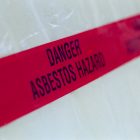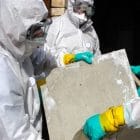What are the first signs of asbestos exposure?
When people know they have been exposed to asbestos exposure, there can be an assumption that part of the symptoms of this would occur in an obvious and immediate way (such as skin irritation, difficulty breathing or some other discomfort or pain). However, part of what makes asbestos so hazardous is that symptoms of exposure occur only when asbestos-caused disease occurs and the damage has been done. This isn’t to say early detection is not a factor to recovery, and knowing these symptoms can be life saving information.
What are the signs of asbestos exposure?
The signs and symptoms of asbestos-caused and -related disease are usually cardio-vascular issues, though can also be present in the colon, throat and stomach and can often be mistaken for other diseases.
Symptoms you are likely to self-identify are:
- Respiratory complications
- Chest pain and tightness
- Dry cough or wheezing
- Shortness of breath
- Cracking sound when breathing
- Abdominal pain and swelling
- Pelvic pain
- Hernia
- Unexplained weight loss
- Loss of appetite
- Difficulty swallowing
- Clubbed fingers
However, you may not be noticing these symptoms, or they may be too mild to give concern. In some cases, asbestos related disease can happen through other routine medical checks. X-rays and CT scans can identify pleural effusion (fluid surrounding the lungs), plagues and thickening which are otherwise undetectable as a physical symptom and can occur anywhere between 10 and 30 years after asbestos exposure.
What is asbestosis?
Asbestosis is a specific chronic lung disease caused by long-term exposure to disturbed asbestos.
When asbestos fibres are inhaled, they can become trapped in the lungs and cause inflammation and scarring over time. This scarring, known as fibrosis, affects the lung tissue’s ability to expand and contract properly, leading to breathing difficulties. The symptoms of asbestosis typically develop slowly and may take several decades to appear after the initial exposure to asbestos.
Unfortunately, there is no cure for asbestosis, and the damage to the lungs is irreversible. Treatment mainly focuses on relieving symptoms, improving lung function, and preventing further complications. This may involve the use of medications to reduce inflammation, supplemental oxygen therapy to assist with breathing, pulmonary rehabilitation programs, and lifestyle changes to promote overall lung health.
Prevention is crucial in minimising the risk of asbestosis. It involves avoiding exposure to asbestos fibres by following safety guidelines and regulations in industries where asbestos is present. If you suspect you have been exposed to asbestos in the past, it is important to inform your healthcare provider so that appropriate monitoring and preventive measures can be taken.
What to do if you are exposed to asbestos in the short term
You don’t need to wait for symptoms to see a health professional for asbestos exposure. If you know you’ve been it is crucial to consult a healthcare professional, particularly one who specialises in occupational or environmental medicine. Inform them about the potential asbestos exposure, including the duration and circumstances of the exposure. They can evaluate your risk and provide guidance on further actions.
If you are already experiencing symptoms, and either know or suspect asbestos exposure, seek immediate medical attention.
To avoid asbestos exposure, opt for professional removal of asbestos at all times. It is never a good idea to risk your own health, and the health and lives of others, by attempting to remove asbestos yourself if you’re not a qualified professional.






